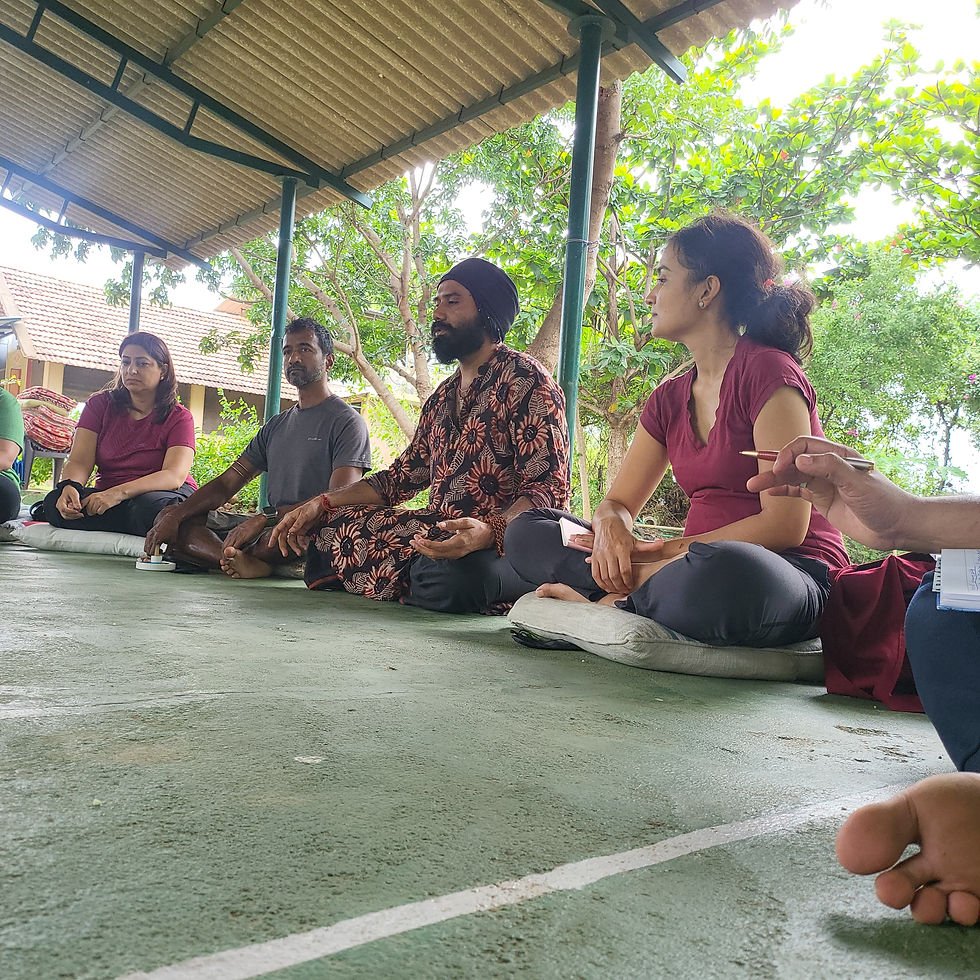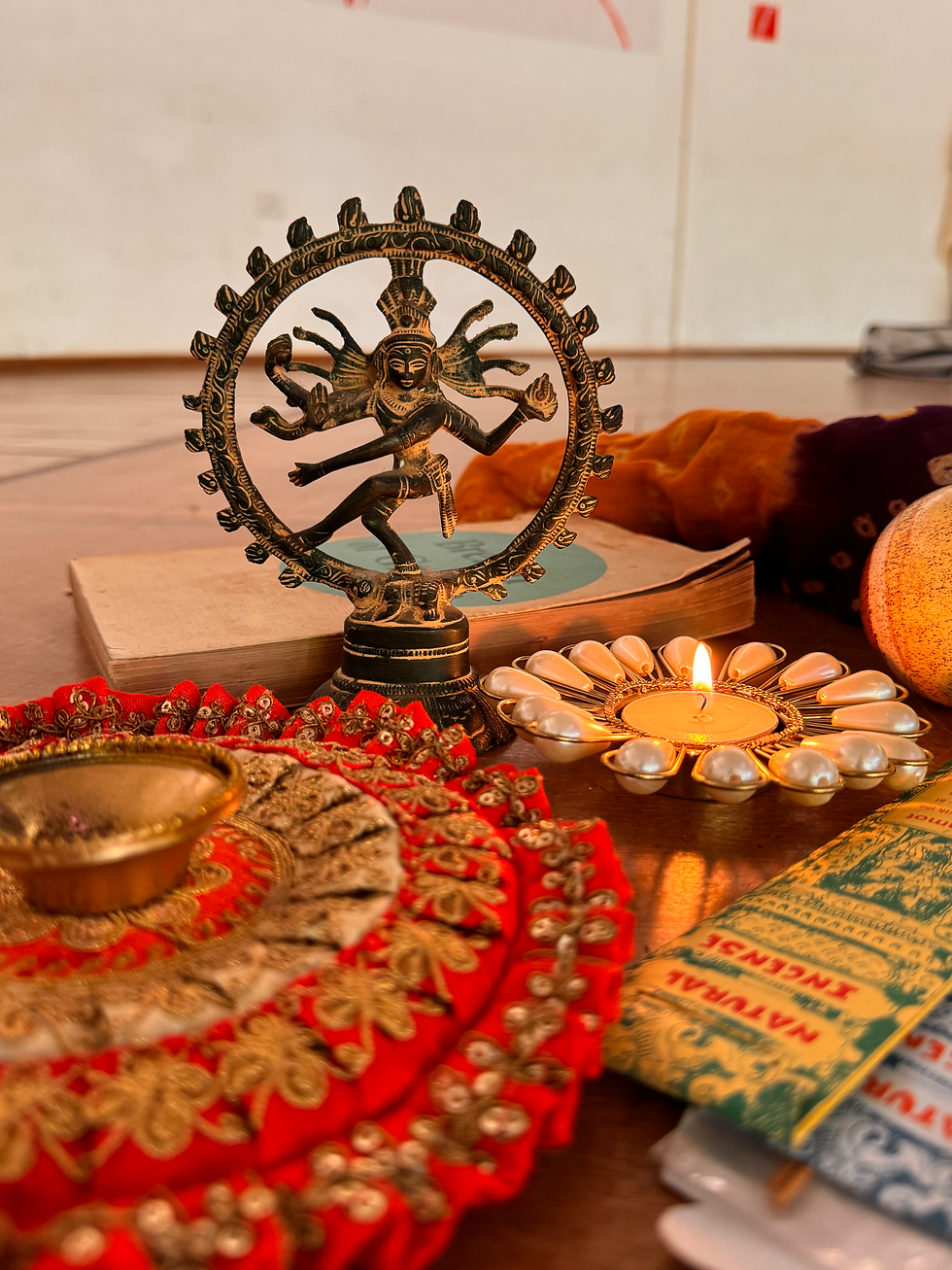The Intersection of Vedic Wisdom and Modern Science
- Vikram Devatha

- Jan 1
- 7 min read
Updated: Aug 7
Siva and Prakriti: The Ultimate Couple
In Hindu philosophy, Siva and Prakriti are the ultimate couple. Siva symbolizes the still, unchanging force behind everything. He is pure energy. Prakriti, on the other hand, is the dynamic, ever-changing force that continuously dances around Him. She represents matter, the substance of everything from stars to trees to you and me. According to the Puranas, Siva and Prakriti are deeply in love and inseparable.
Prakriti goes by other names such as Sati, Parvati, and Shakti, each with unique philosophies and mythologies. Remember how Siva caused havoc when Sati stepped into Daksha's Yagya? He lamented in sorrow until she reincarnated as Parvati, leading to their reunion.
When discussing Siva and Prakriti, we're essentially referring to energy and matter. These two concepts are interconnected; they can’t be separated but can transform into one another. This relationship is summed up in Einstein's famous equation, E=mc². They are two sides of the same coin, just like Siva and Prakriti!
If you're resonating with me on this, can we further declare that whenever the Vedas and Puranas mention Siva and Parvati, they essentially describe the relationship between energy and matter? Physics teaches us that energy can never be destroyed; it can only be transformed. This aligns perfectly with our understanding of Siva—He is indestructible and the most powerful god of all!
Energy and matter are distinct yet interlinked. Energy animates matter, while matter provides a framework for energy to flow. It's a dance where one cannot exist without the other, just as Siva and Prakriti do.

Concept of Maya: Illusion or Reality?
The term "Maya" originates from the Sanskrit root "ma," meaning "to measure," combined with "aya," meaning "to lend itself." Together, Maya translates to "that which lends itself to be measured." Often, it is simply translated as "illusion," misleading us into believing the universe is false or unreal. This interpretation isn't entirely accurate. When we claim the universe is Maya, we do not imply it doesn't exist. Rather, we suggest that the universe appears finite, divisible, and tangible—though, in reality, it is immeasurable.
In Vedanta, Maya isn't regarded as negative or deceptive. Instead, it embodies a divine play, a lila. Through Maya, the Infinite takes form as the measurable and finite. This playful transformation enables us to interact with the world. Without Maya, there would be no matter, time, or space—only the Infinite, beyond all names and forms.
The Nature of Time and Space
According to Indian philosophy, what we perceive as time and space are constructs of Maya. Beyond this, there is no "before" or "after," no "here" or "there." There is only the infinite now, a reality that transcends measurement and perception. This notion challenges our understanding of the universe. What we see as solid and measurable is merely a framework allowing the Infinite to be experienced. Maya makes the unmeasurable appear measurable, facilitating life's unfolding.
Maya in Science
Modern physics remarkably aligns with ancient ideas about Maya. Did you know scientists observe that matter is primarily empty space? Subatomic particles, the building blocks of matter, act not as solid entities but as energy and probabilities. What seems solid and measurable is fundamentally empty space, suggesting that our perception of concrete reality is ultimately a manifestation of nothingness. This Empty Space, which transcends time and measurement, expresses the Infinite as the finite! Both modern science and ancient Vedanta articulate the same truth: the universe is not as it appears.
When exploring this rabbit hole further, I find Quantum Physics aligning beautifully with Vedic mythology. Today’s scientists assert that matter, at its smallest level, consists mainly of empty space—pure energy lacking tangible existence. Subatomic particles float and dance around an unchanging center. This dynamic mirrors the Vedic depiction of Siva and Prakriti.
Siva, the still, indestructible Being, remains in perpetual meditation, while Prakriti embodies the ever-changing dance of nature aspiring to capture His heart. Science states energy cannot be destroyed, paralleling the Puranas that describe Siva as unrivaled and unconquerable.
The tales of Siva, Sati, and Parvati elegantly illustrate the magnificent universe we inhabit, crafting narratives that even children can comprehend and remember.
The Cyclical Universe in Ancient Wisdom and Modern Science
The cyclical theory of the universe posits that the Big Bang is not a singular event but part of an infinite loop of births and deaths, encompassing phases of expansion and contraction leading to "rebirth." This theory suggests that the universe begins with a Big Bang, expands for billions of years, then gradually slows down and contracts due to gravity. Currently, we are in a phase of expansion, but experts agree that this rate will eventually decline, leading to a Big Crunch wherein everything collapses back to a dense point—a new Big Bang signals the cycle’s restart. Hence, the universe is without beginning or end!
This concept beautifully intersects with Hindu Cosmology, which describes the universe as eternally cyclical. Various Hindu scriptures partition time into vast cycles called Kalpas, each consisting of creation, preservation, and destruction governed by Brahma, Vishnu, and Siva. After each destruction, the universe doesn't vanish; rather, it rests for a time before being reborn in a new cycle. Siva leads to Brahma again, continuing the cycle.
The life span of the universe is termed one "maha kalpa," spanning several hundred trillion years—equating to one breath of Vishnu. As He exhales, legions of universes emerge, birthing a "Brahma" in each. Upon Vishnu's inhalation, all universes are reabsorbed, and Brahma ceases to exist. This cycle of eternal rebirth resonates with modern scientific theories of expansion, contraction, and renewal.
Karma: Cause and Effect
The law of Karma applies across all universes. This principle aligns with Newton's 3rd law of motion! Newton postulates that every action has an equal and opposite reaction. This mirrors the law of karma, which states all our actions yield consequences. Good actions result in positive outcomes, while negative actions cause harm—across the physical, mental, or emotional realms.
While scientists apply Newton’s laws to inanimate objects, the law of karma encompasses living beings. Both laws are centered on cause and effect: our actions reflect back upon us. Our past thoughts and actions dictate our current life circumstances, while our present decisions will shape our future. This culminates in our understanding of Fate. However, the choices made today determine future destinies.
Going Beyond Science
Newton’s principles of action and reaction resonate with the law of Karma. However, scientists assert that Newton’s laws falter within the quantum realm. Today, experts indicate that the rules governing physical reality do not apply at the quantum level. This realization brings us to an essential understanding: the law of Karma pertains exclusively to the tangible world, not to the eternal, unchanging essence—Purusha, which exists beyond cause and effect.
This insight mirrors teachings put forth in the Vedas. They explicate that Purusha, the Absolute Self, remains untouched by karma and cycles of birth and death. In contrast, Prakriti—the dynamic, ever-changing material world—dances around the eternal witness.
This raises an important question: how do we perceive ourselves? Do we view ourselves as part of the material world, bound by karma, or as the unchanging Self, free from cycles of birth and rebirth?
When we begin to identify with Purusha within us, we tap into the silent, unmeasurable essence residing in each cell. This identification liberates us from the cycles of rebirth. The Vedas encourage this journey: moving from Prakriti, the measurable, toward the realization of Siva, the unchanging and formless, which remains immeasurable. This transformation leads us beyond cause and effect and into the realm of the infinite. By shifting our awareness to this eternal essence, we transcend the laws of karma, uncovering the immeasurable.
Purusha and Prakriti are recognized under various names across different traditions. They manifest as Siva and Shakti in the Puranas, the Eternal and the Temporal in the Vedas, the Real and the Unreal in the Upanishads, Ether and the Elements in Jyotish, Buddha-nature and Samsara in Buddhism, the Tao and the Manifested World in Taoism, and Energy and Matter in Science.
Stepping into the World of Siva
Despite their efforts, scientists struggle to fully grasp the quantum world. How could they succeed when they observe the unmeasurable using tools of measurement? It's akin to peeking outside your house from your window; true comprehension of the outside world requires stepping beyond the threshold. To genuinely understand Purusha—the unchanging and formless—we must become it. This involves transcending mere observation and identifying with the stillness within.
The Vedas provide various paths to facilitate our shift from Prakriti to Purusha, from the measurable to the immeasurable. Jnana Yoga encourages us to ask "Who am I?" and discover answers without employing labels or metrics. In Bhakti Yoga, we wholeheartedly surrender to that which eludes measurement. Karma Yoga emphasizes acting without a sense of doership or attachment to outcomes, recognizing our true self lies beyond consequences. In Raja Yoga, we cultivate silence and stillness in the mind to resonate with the immeasurable within us. Each path offers a unique approach to realize our essence beyond names, forms, and measurements. They lead us to understand that our true nature is infinite, timeless, and unchanging.
This journey transitions us from the finite to the infinite. It involves realigning our identification from the fluctuating material world to the eternal, unchanging essence within us. It is not merely about understanding the unmeasurable; it is about becoming it. The Vedas beckon us to embark on this liberating path, filled with freedom and infinite potential. By entering the world of Siva, we transcend karma cycles and realize our true nature as the eternal Purusha.
As we explore both ancient wisdom and modern science, we discover they are not so dissimilar. They converge on a profound truth: the Universe, in all its manifestations, embodies a dance between the measurable and the immeasurable, the finite and the infinite. The Vedas invite us to transcend the realm of forms, surpass the cycles of karma, and embrace the still, unchanging essence of Purusha. Through this shift in awareness, we venture beyond the material into the eternal; this journey encompasses both discovery and transformation.
P.S.
If you enjoyed this post, consider subscribing to my mailing list to receive articles like this directly in your inbox. You can subscribe by clicking here: https://www.allthingsvedic.in/blog.
I write occasionally about my learnings and experiences in Vedic Astrology. My blog has been recognized as one of the Top 15 Vedic Astrology Blogs on the web by Feedspot. You can also follow me on Instagram and Facebook, where I share my artwork:
Instagram: https://www.instagram.com/allthingsvedic.in/
Facebook: https://www.facebook.com/allthingsvedic
Additionally, I have a free WhatsApp group where I share thoughts, tips, and suggestions related to Vedic Astrology to enhance your days: https://chat.whatsapp.com/C4o6omqZVfeGXE3CWeDxLU.
If you wish to learn with me, here are some of the programs I’m offering: https://www.allthingsvedic.in/learn.




Comments